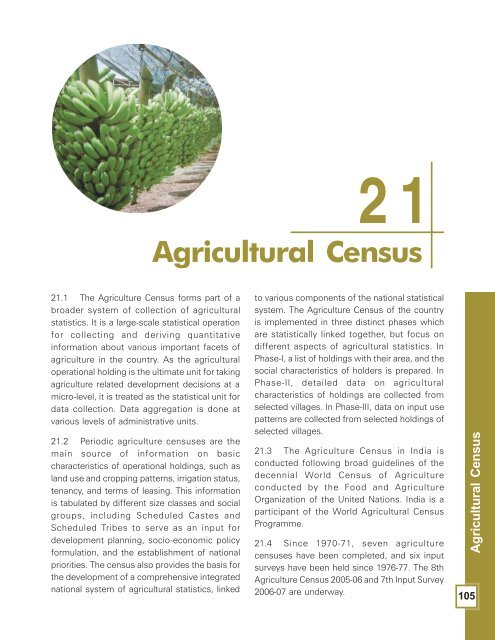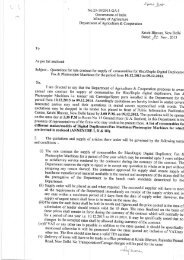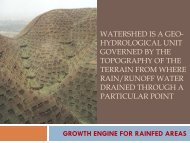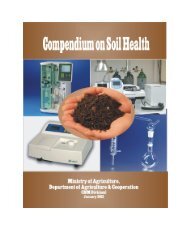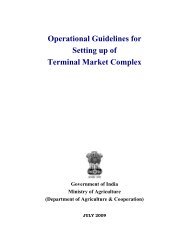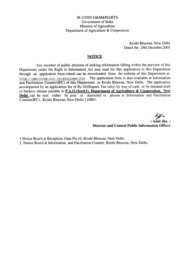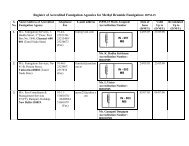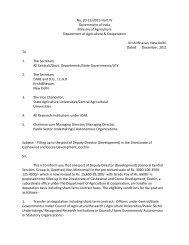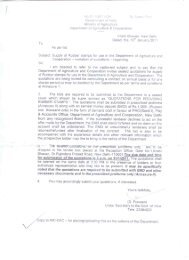Annual Report 2009-2010 - Department of Agriculture & Co-operation
Annual Report 2009-2010 - Department of Agriculture & Co-operation
Annual Report 2009-2010 - Department of Agriculture & Co-operation
Create successful ePaper yourself
Turn your PDF publications into a flip-book with our unique Google optimized e-Paper software.
21.1 The <strong>Agriculture</strong> Census forms part <strong>of</strong> a<br />
broader system <strong>of</strong> collection <strong>of</strong> agricultural<br />
statistics. It is a large-scale statistical <strong>operation</strong><br />
for collecting and deriving quantitative<br />
information about various important facets <strong>of</strong><br />
agriculture in the country. As the agricultural<br />
<strong>operation</strong>al holding is the ultimate unit for taking<br />
agriculture related development decisions at a<br />
micro-level, it is treated as the statistical unit for<br />
data collection. Data aggregation is done at<br />
various levels <strong>of</strong> administrative units.<br />
21.2 Periodic agriculture censuses are the<br />
main source <strong>of</strong> information on basic<br />
characteristics <strong>of</strong> <strong>operation</strong>al holdings, such as<br />
land use and cropping patterns, irrigation status,<br />
tenancy, and terms <strong>of</strong> leasing. This information<br />
is tabulated by different size classes and social<br />
groups, including Scheduled Castes and<br />
Scheduled Tribes to serve as an input for<br />
development planning, socio-economic policy<br />
formulation, and the establishment <strong>of</strong> national<br />
priorities. The census also provides the basis for<br />
the development <strong>of</strong> a comprehensive integrated<br />
national system <strong>of</strong> agricultural statistics, linked<br />
21<br />
Agricultural Census<br />
to various components <strong>of</strong> the national statistical<br />
system. The <strong>Agriculture</strong> Census <strong>of</strong> the country<br />
is implemented in three distinct phases which<br />
are statistically linked together, but focus on<br />
different aspects <strong>of</strong> agricultural statistics. In<br />
Phase-I, a list <strong>of</strong> holdings with their area, and the<br />
social characteristics <strong>of</strong> holders is prepared. In<br />
Phase-II, detailed data on agricultural<br />
characteristics <strong>of</strong> holdings are collected from<br />
selected villages. In Phase-III, data on input use<br />
patterns are collected from selected holdings <strong>of</strong><br />
selected villages.<br />
21.3 The <strong>Agriculture</strong> Census in India is<br />
conducted following broad guidelines <strong>of</strong> the<br />
decennial World Census <strong>of</strong> <strong>Agriculture</strong><br />
conducted by the Food and <strong>Agriculture</strong><br />
Organization <strong>of</strong> the United Nations. India is a<br />
participant <strong>of</strong> the World Agricultural Census<br />
Programme.<br />
21.4 Since 1970-71, seven agriculture<br />
censuses have been completed, and six input<br />
surveys have been held since 1976-77. The 8th<br />
<strong>Agriculture</strong> Census 2005-06 and 7th Input Survey<br />
2006-07 are underway.<br />
Agricultural Census<br />
105


